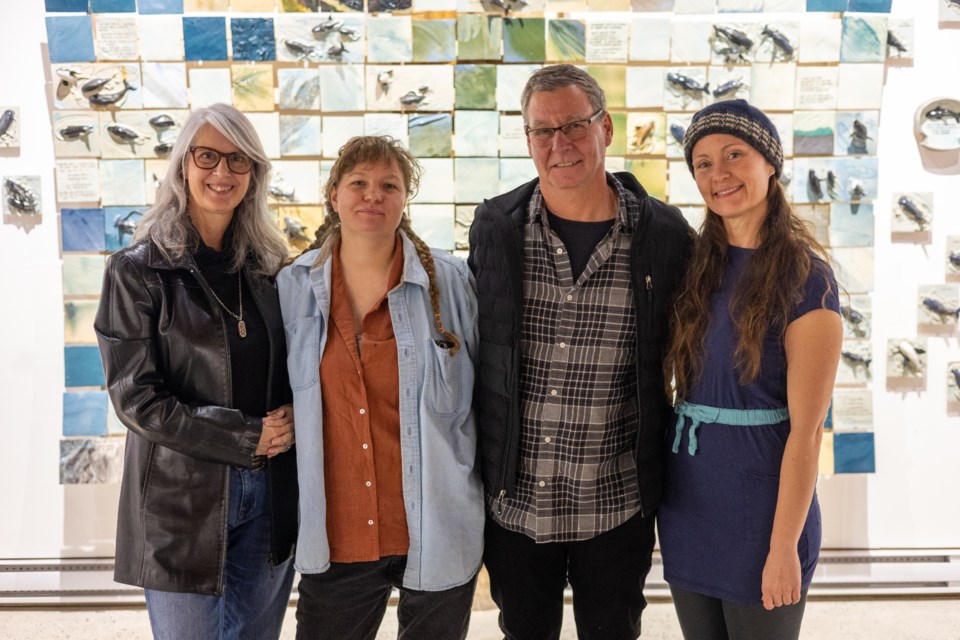The final chapter of the 2024 Sechelt Arts Festival began on Nov. 15, illuminating — literally — scores of admirers who attended its opening reception. Light projections by Mieke Bray painted the exterior of the Sunshine Coast Arts Centre in shades and patterns evoking an oceanic ebb and flow.
Bray is one of nine headliners whose works are featured in Our Salish Sea, the culminating exhibition of the festival in its first year under the auspices of the Sunshine Coast Arts Council.
“Part of what we’ve been doing as the new stewards of the Sechelt Arts Festival is to try and understand how a festival can actually echo the rhythms of the seasons in this place,” said Sadira Rodrigues, the council’s curator and director. “This year we have unfolded a number of projects that start to look at what a festival looks like in our specific context. The exhibition is not just the presentation of work but it’s really the culmination of a series of engagements.”
In late summer, the arts council united creatives and conservationists for a “field school” in the Chapman Creek estuary. Participants considered the responsibilities carried by humans who live in the vicinity. Rodrigues shared inspiration from Potawatomi author and botanist Robin Wall Kimmerer, whose work defines a “grammar of animacy.”
“We think of our ecologies and our environments not as things,” Rodrigues explained, “but as a series of complex relationships that we are bound to.”
After attending the field school, artist Laura Piersol used organic elements from a trail near her home to create natural inks. The tones in her work Water’s Path on the Earth’s Skin form a rivulet of colour, reflecting dominant hues of the landscape on each step toward the sea. The ink’s serpentine course extends beyond the boundaries of watercolour papers, twisting and branching into a flow of kaleidoscopic complexity.
Métis-Cree filmmaker Kamala Todd produced a video installation titled water rock kin. The dynamic textures of surf at Davis Bay pulse within the linear constraints of a TV screen. Nearby, smooth stones gathered from the same location repose in bowls like an offering.
Nearly a full wall of the gallery is occupied by The Southern Resident Killer Whales, by Clare Wilkening. The grid of painted ceramic tiles includes representations of every mammal documented as a South Resident Killer Whale. Wilkening began the work eight years ago and intends to continue updating it for the rest of her life as she learns of births and deaths in the population. Only 72 individuals remain in the subspecies.
“Every time I set it up it’s a different painting,” said Wilkening. “Hopefully it will become a [lifelong] practice in watching the whales grow and thrive. But there’s a lot of political and policy and cultural attitudes that need to change for that to happen.”
Three-dimensional collage by Nadina Tandy is a subtle homage to the lab work of her father, who worked for BC Fisheries in the 1960s and 1970s. Titration glassware, scales and a hotplate are arranged as a still life sculpture beneath Tandy’s graphic harmonies of scientific texts, fish fragments and painterly backgrounds. Each of Tandy’s “seeded note books” use one sheet of paper as the substrate for various source materials, then are folded into book form.
One book is filled with the history of marine ichthyological collections. “It raises profound questions,” said Tandy. “Who is the ichthyologist naming the fish and how did we arrive at this point? While I do not have answers, I offer my emotional translations as a means of engagement. In an unexpected way, this journey resonates as a coming home — much like the end of the salmon’s odyssey.”
A multidisciplinary approach links many of the artists and their works, as in M. Simon Levin’s Watershed Loss. Levin combines digital photography and twigs from cedar, fir, alder and huckleberry to depict the flow of water from the Chapman Lake reservoir. “I was very interested in having a conversation about perceptions that are not human,” said Levin, “where we don’t human-centre this idea of water but we try to imagine that we share water with it all: non-human animals, the land, the soil and the trees.”
Our Salish Sea remains on display until Dec. 14, when it will conclude with a closing party featuring visuals by Mieke Bray.



